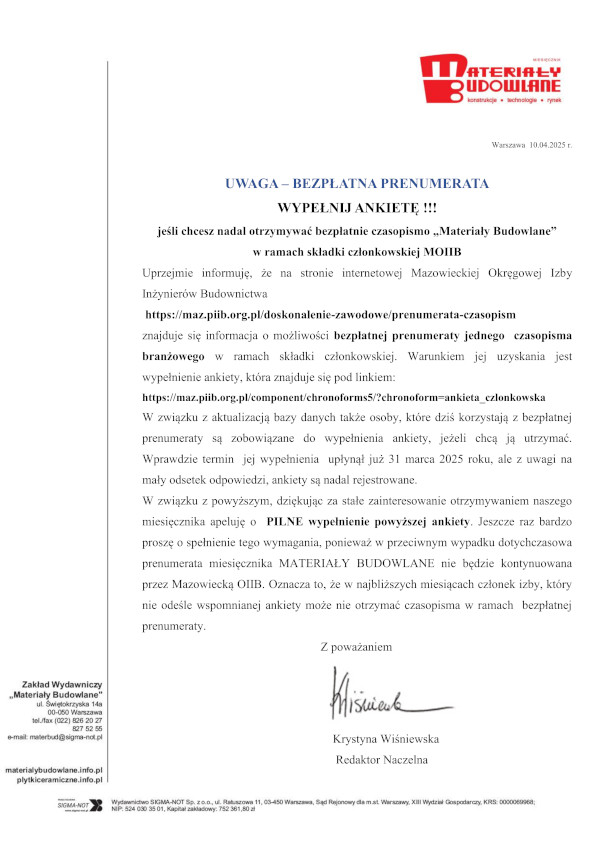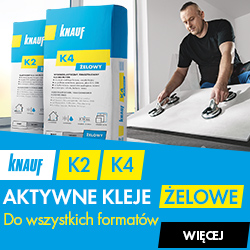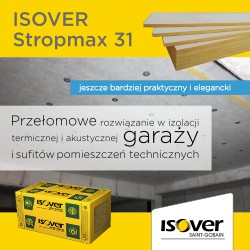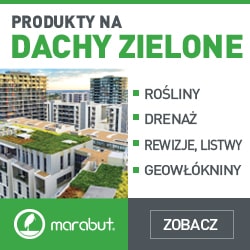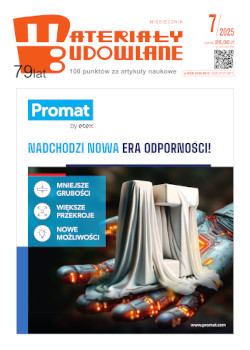Environmental characteristic of External Thermal Insulation Composite Systems (ETICS) with expanded polystyrene boards and mineral wool
mgr inż. Sebastian Czernik, Atlas sp. z o.o.
dr inż. Marta Marcinek, Atlas sp. z o.o.
dr inż. Bartosz Michałowski, Atlas sp. z o.o.
ORCID: 0000-0002-3955-2924
dr inż. Michał Piasecki, Instytut Techniki Budowlanej
ORCID: 0000-0002-0201-0478
dr inż. Justyna Tomaszewska, Instytut Techniki Budowlanej
ORCID: 0000-0002-2037-0768
dr inż. Jacek Michalak, Atlas sp. z o.o.
ORCID: 0000-0001-7186-6774
Adres do korespondencji: Ten adres pocztowy jest chroniony przed spamowaniem. Aby go zobaczyć, konieczne jest włączenie w przeglądarce obsługi JavaScript.
DOI: 10.15199/33.2021.03.07
Studium przypadku
Streszczenie. W artykule przedstawiono oszacowanie oddziaływań i aspektów środowiskowych złożonych zestawów izolacji cieplnej ETICS z warstwą izolacyjną wykonaną z płyt ekspandowanego polistyrenu (EPS) lub wełny mineralnej (MW), pokrytych zaprawą do wykonywania warstwy zbrojonej oraz tynkiem silikonowo-silikatowym. Wskaźniki oddziaływania środowiskowego obliczono, wykorzystując metodę oceny cyklu życia (LCA). Analiza obejmowała moduły od A1 do A3, tj. od wydobycia surowców aż do gotowego wyrobu dostarczonego do bramy fabryki. Porównanie wartości wskaźników charakterystyk środowiskowych dotyczących wyprodukowania ETICS z płytami EPS lub MW wskazuje, że układy z wełną mineralną stanowią większe obciążenie dla środowiska.
Słowa kluczowe: złożony zestaw izolacji cieplnej (ETICS); deklaracja środowiskowa III typu (EPD); potencjał globalnego ocieplenia (GWP); analiza cyklu życia (LCA);materiały termoizolacyjne.
Abstract. The paper shows the results of the estimation of environmental impacts and aspects of external thermal insulation composite system (ETICS) with expanded polystyrene (EPS) or mineral wool (MW) boards covered with an adhesive for a base coat and silicone-silicate render as the top layer. The environmental impact indicators of the considered systems were calculated using the Life Cycle Assessment (LCA) method. Analysis has covered modules from A1 to A3, i.e., from raw material extraction to the finished product delivered to the factory gate. Comparing the values of the environmental characteristics indicators for the production of ETIC Swith EPS or MW boards shows that systems with mineral wool constitute a more significant burden on the environment.
Keywords: External Thermal Insulation Composite System (ETICS); Environmental Product Declaration (EPD); Global Warming Potential (GWP); Life Cycle Assessment (LCA); thermal insulation materials.
Literatura
[1] Andersen S. C., H. F. Larsen, L. Raffnsoe, C. Melvang. 2019. „Environmental Product Declarations (EPDs) as a competitive parameter within sustainable buildings and building materials”. w IOP Conference Series: Earth and Environmental Science 323 (1): 012145. DOI: 10.1088/1755-1315/323/1/012145.
[2] Anderson Jane. 2020. Construction LCA’s 2020 Guide to Environmental Product Declarations. https://infogram.com/constructionlcas-2020-guideto- epd-1h7g6kgqx9zo4oy? live (24.10.2020).
[3] Anderson Jane, Alice Moncaster. 2020. „Embodied carbon of concrete in buildings, Part 1: analysis of published EPD”. Buildings and Cities 1 (1): 198 – 217. DOI: 10.5334/bc.59.
[4] Balaras Constantinos A., Kalliopi Droutsa, Elena Dascalaki, Simon Kontoyiannidis. 2005. „Heating energy consumption and resulting environmental impact of European apartment buildings”. Energy Build. 37: 429 – 442. DOI: 10.1016/j. enbuild. 2004.08.003.
[5] Bitsiou E., C. Giarma. 2020. „Parameters related to building components” life-cycle analysis in methods for buildings” environmental performance assessment”. IOP Conference Series: Earth and Environmental Science 410 (1): 012066. IOP Publishing.DOI: 10.1088/1755-1315/410/1/012066.
[6] Braulio-GonzaloMarta,Maria D. Bovea. 2017. „Environmental and cost performance of building’s envelope insulation materials to reduce energy demand: Thickness optimization”. Energy and Buildings 150: 527–545. DOI: 10.1016/j. enbuild. 2017.06.005.
[7] Building Performance Institute Europe. 2017. http://bpie.eu/wp-content/uploads/2017/12/Stateof- the-building-stock-briefing_Dic6.pdf. (22.10.2020).
[8] Cirami Simona, Gianpiero Evola, Antonio Gagliano, GiuseppeMargani. 2017. „Thermal and economic analysis of renovation strategies for a historic building in mediterranean area”. Buildings 7 (3): 60. DOI: 10.3390/buildings7030060.
[9] EOTA. 2013. ETAG 004: Guideline for European Technical Approval of External Thermal Insulation Composite Systems (ETICS) with Rendering. https://www.eota.eu/en-GB/content/ etags/26/. Bruksela.
[10] Galindro Bruno Menezes, Sebastian Welling, Niki Bey, Stig Irving Olsen, Sebastiao Roberto Soares, Sven-Olof Ryding. 2020. „Making use of life cycle assessment and environmental product declarations: A survey with practitioners”. Journal of Industrial Ecology. DOI: 10.1111/jiec.13007.
[11] Gelowitz M. D. C., J. J. McArthur. 2016. „Investigating the effect of environmental product declaration adoption in LEED® on the construction industry:Acase study”.ProcediaEngineering 145: 58 – 65. DOI: 10.1016/j.proeng. 2016.04.014.
[12] ITB. 2016. Aprobata Techniczna ITB AT-15- 9090/2016 „Zestaw wyrobów do wykonywania ociepleń ścian zewnętrznych budynków systemem Atlas ETICS”. Warszawa. (09.08.2016).
[13] ITB. 2016. Aprobata Techniczna ITB AT-15- 2930/2016 „Zestaw wyrobów do wykonywania ociepleń ścian zewnętrznych budynków systemem Atlas ETICS Roker”. Warszawa. (09.08.2016).
[14] ITB. 2019. Deklaracja środowiskowa III typu. „Zestaw wyrobów do wykonywania ociepleń ścian zewnętrznych budynków systemem Atlas ETICS”. Warszawa. (03.2019).
[15] ITB. 2019. Deklaracja środowiskowa III typu. „Zestaw wyrobów do wykonywania ociepleń ścian zewnętrznych budynków systemem Atlas ETICS”. Warszawa. (03.2019).
[16] ITB.2020.https://www.itb.pl/epd.html(29.10.2020).
[17] Kienzlen Volker, Hans Erhorn, Helmut Krapmeier, Thomas Lützkendorf, Johannes Werner, Andreas Wagner. 2014. The significance of thermal insulation Arguments aimed at overcoming misunderstandings. III wydanie. KEA Climate Protection and Energy Agency of Baden- Württemberg GmbH: Karlsruhe.
[18] Komisja Europejska. 2018. Informacja prasowa Dyrektywa Parlamentu Europejskiego i Rady (UE) 2018/844. https://ec.europa.eu/commission/presscorner/ detail/en/IP_18_3374. (22.10.2020).
[19] Komisja Europejska. 2018. Dyrektywa Parlamentu Europejskiego i Rady (UE) 2018/844. https://ec.europa.eu/energy/topics/energy-efficiency/ energy-efficient-buildings/energy-performance- -buildings-directive_en. (21.10.2020).
[20] Komisja Europejska. 2019. Europejski Zielony Ład. Bruksela. https://ec.europa.eu/info/strategy/ priorities-2019-2024/european-green-deal_ pl.(21.10.2020).
[21] Komisja Europejska. 2020.ARenovationWave for Europe – greening our buildings, creating jobs, improving lives. Bruksela. https://ec. europa. eu/energy/sites/ener/files/eu_renovation_wave_ strategy. pdf. (22.10.2020).
[22] Kraus Michal, Katařina Žáková, Jaroslav Žák. 2020. „Economic-Environmental and Technological Assessment of ETICS”. Easy Chair 3425.
[23] Lembo Filiberto, Francesco Paolo R. Marino. 2016. „The Pathologies of the ETICS”. w Recent Developments in Building Diagnosis Techniques: 37 – 49, Springer, Singapore.
[24] Librelotto Lisiane Ilha, Marija Kekez, Helena Maria Galha Bártolo. 2020. „The environmental impact of ETICS layer: A case of study with life cycle assessment (LCA) from environmental product declaration (EPD) in Portugal”. MIX Sustentável 6(2): 139-148. DOI: 10.29183/2447- 3073.MIX2020.v6.n2.139-148.
[25] Matos Marta, Liliana Soares, Luis Silva, Pedro Sequeira, Joaquim Carvalho. 2020. „Life Cycle Assessment of an ETICS system composed of a natural insulationmaterial: a case study of a systemusing an insulation cork board (ICB)”. w Portugal SB13 contribution of sustainable building to meet EU 20- 20-20 targets. chapter 11, 855-862. https://www.irbnet. de/daten/iconda/CIB_DC26483.pdf.
[26] Michalak Jacek, Sebastian Czernik, Marta Marcinek, Bartosz Michałowski. 2020. „Environmental Burdens of External ThermalInsulation Systems. Expanded Polystyrenevs. Mineral Wool: Case Study from Poland”. Sustainability 12: 4532. DOI: 10.3390/su12114532.
[27]Michałowski Bartosz, Marta Marcinek, Justyna Tomaszewska, Sebastian Czernik, Michał Piasecki, RobertGeryło, JacekMichalak. 2019. „Charakterystyka środowiskowa systemów ETICS w latach 2014 – 2019 (Environmental characteristics of the ETICS systems between 2014 and 2019”. Materiały Budowlane 12: 22–25.DOI: 10.15199/33.2019.12.02.
[28] Michałowski Bartosz, Marta Marcinek, Justyna Tomaszewska, Sebastian Czernik, Michał Piasecki, Robert Geryło, JacekMichalak. 2020. „Influence of rendering type on the environmental characteristics of expanded polystyrene-based external thermal insulation composite system”. Buildings 10: 47. DOI: 10.3390/buildings10030047.
[29] Minarovičová Katarina, Dušan Dlhý. 2018. „Environmentally safe system for treatment of bio corrosion of ETICS”. w MATEC Web of Conferences 146: 03005). EDP Sciences. DOI:10.1051/matecconf/201814603005.
[30] ONZ. 1987. Report of the World Commission on Environment and Development: Our Common Future, Chapter 2: Towards Sustainable Development. Nowy Jork. http://www.un-documents. net/ocf-02.htm. (22.10.2020).
[31] Pasker Ralf. 2017. „The European ETICS market – Do ETICS sufficiently contribute to meet political objectives?” 4th European ETICS Forum; Warszawa.
[32] Passer Alexander, Helmut Kreiner, Peter Maydl. 2012. „Assessment of the environmental performance of buildings: A critical evaluation of the influence of technical building equipment on residential buildings”. The International Journal of Life Cycle Assessment 17(9): 1116 – 1130. DOI: 10.1007/s11367-012-0435-6.
[33] Passer Alexander, Sebastian Lasvaux, Karen Allacker, Dieter De Lathauwer, Carolin Spirinckx, Bastian Wittstock, Daniel Kellenberger, Florian Gschösser, Johannes Wall, Holger Wallbaum. 2015. „Environmental product declarations entering the building sector: critical reflections based on 5 to 10 years experience in different European countries”. The International Journal of Life Cycle Assessment 20 (9): 1199 – 1212. DOI: 10.1007/s11367-015-0926-3.
[34] Potrč Tajda, Katja Malovrh Rebec, Friderik Knez, Roman Kunič, Andraž Legat. 2016. „Environmental footprint of external thermal insulation composite systems with different insulation types”. Energy Procedia 96: 312 – 322. DOI: 10.1016/j.egypro.2016.09.154.
[35] Rozporządzenie Parlamentu Europejskiego i Rady (UE) nr 305/2011 z 9 marca 2011 r. ustanawiające zharmonizowane warunki wprowadzania do obrotu wyrobów budowlanych i uchylające dyrektywę Rady 89/106/EWG. 2011. Dziennik Urzędowy Unii Europejskiej. L88, 5-43.
[36] Sattler Stefan, Doris Österreicher. 2019. „Assessment of sustainable construction measures in building refurbishment – life cycle comparison of conventional and multi-active façade systems in a social housing complex”. Sustainability 11 (16): 4487. DOI: 10.3390/su11164487.
[37] Sierra-Pérez Jorge, Jesús Boschmonart- Rives, Xavier Gabarrell. 2016. „Environmental assessment of façade-building systems and thermal insulation materials for different climatic conditions”. Journal of cleaner production 113: 102 – 113. DOI:10.1016/j.jclepro.2015.11.090.
Przyjęto do druku: 22.12.2020 r.
Materiały Budowlane 03/2021, strona 40-44 (spis treści >>)


